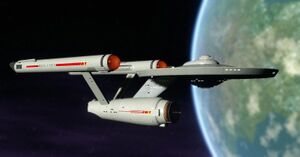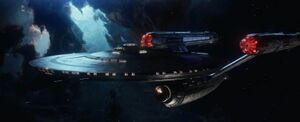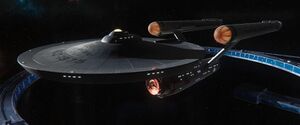User:Teylasramar/Sandbox/Constitution class
More actions
The Constitution-class heavy cruiser is a legendary starship design often considered to be the exemplar of both Starfleet’s mission and its design ethos. First built in the 2240s, they remained Starfleet’s premiere heavy cruiser until the 2270s, having been refit and overhauled numerous times over those three decades until the changes became so substantial that the class was succeeded by its Enterprise sub-class, known officially as the Constitution II-class.
History
Genesis
By the 2220s, the United Federation of Planets Starfleet had established its mission and its philosophy as being distinct both from the United Earth Starfleet and the stellar services of the Tellarites, Vulcans, and Andorians, but its shipbuilding practices continued to be largely fragmented. Vulcans built science ships, Andorians built warships, Tellarites built trade vessels, and Humans built a little bit of everything. In some ways this was advantageous—national shipyards could excel in what they were good at—but the Federation had yet to truly synergize the strengths of its member worlds into a cohesive technological platform. Named for the idea of the governing documents of a union serving to strengthen its people, Project Constitution was ordered in 2230 as a way of unifying the technological abilities of the Federation’s members into a single vessel that would embody Starfleet’s core missions of exploration, diplomacy, defense, and mercy for missions far beyond explored space.
Starfleet Engineering created the Advanced Starship Design Bureau to design the Constitution, with its headquarters and production facility located in the heart of the Federation at San Francisco Fleet Yards. The design process was slow and methodical, taking nearly fifteen years before the first two vessels left the yards. The brief was not just to create a starship that incorporated aspects of various member worlds’ achievements but to go beyond them to create a vessel that innovated in every area. This would be the largest, most elaborate, and most capable starship yet fielded by Starfleet, taking on a crew of 500 humanoids for voyages of five years with minimal outside support.
Constitution herself, NX-1700, and the yet-unnamed NCC-1701 were laid down at San Francisco Fleet Yards in 2234, the former under the supervision of Admiral Matt Jefferies and the latter under then-Captain Robert April. The construction project was a truly multi-species affair, with each systems team purposefully composed of officers from across Starfleet’s own yards and the shipyards of member races. This initially led to conflict, but the management styles of Jefferies and April allowed every member of each team to find their own way of contributing to the project as a whole—this also served as a blueprint for operational procedures and command techniques for managing large multi-species crews, as this was something that Starfleet still lacked significant experience in.
Thanks to the success of the construction process, the order was increased to six vessels in 2238, and Constellation, Republic, and Intrepid were laid down that same year.
As the design evolved, many areas of the Constitution-class spaceframe were built to be modular and easily reconfigurable to allow the design to be upgradeable, something that proved to be prescient as the class would have many minor upgrades and two major redesigns over its service life. The saucer section in particular was designed to be able to handle anywhere from two-hundred to five-hundred crew, with space for labs, recreational facilities, and sickbays alterable to suit different mission parameters and crew sizes. This was made possible by locating the majority of the ship’s larger equipment—the deflector dish, warp core, cargo holds, hanger, etc.—in the secondary hull, so that the primary hull was reserved for crew support and mission-specific equipment. The initial two vessels were configured to support a crew of 450, with a generalist lab arrangement and volume reserved for diagnostic computers to evaluate them during their shakedowns.

Early Service
Constitution, Constellation, and Enterprise were sent on their first five-year missions in 2245, with Captain Garth of Izar commanding Constitution, Captain Robert April commanding Enterprise, and Captain Matt Decker commanding Constellation, under the careful watch of Admiral Jefferies. The initial three ships were very successful in their first two years of service, and even as Republic and Intrepid were still nearing completion, Starfleet increased the order to twelve total Constitution-class starships. A number of other classes using the same technological base, such as the Bellerophon, Radiant, and Archer classes were also ordered around this time.
The concept of a Five-Year Mission was prototyped aboard the original Constitution-class vessels as a new way of managing the command and staffing of starships. It was not uncommon for short-range vessels to have a captain for a few months at a time or even for a single mission and regular contact with starbases allowed for frequent crew rotations. As the Constitution was intended to be much more independent, a structure was developed that commissioned each captain to a five-year stint aboard their vessel, with a command crew that was intended to be more or less stable. This required new regulations for managing crew advancement in the field, as well as new strategies for making a starship a comfortable and fulfilling place to spend five years of one’s life.
Mid Career
In 2250, Constitution, Constellation, and Enterprise all completed their first five-year missions to widespread acclaim. While Garth of Izar and Decker remained at their posts, Robert April was promoted to flag rank and, as the newly-minted Director of Deep Space Operations, became the supervisor of the entire Constitution fleet.
A decade into their service, the Constitution class received their first major overhaul in 2255, with widespread systems upgrades and a shrinking of the crew by two hundred to optimize them for longer deep space missions. This allowed for larger and more spacious quarters, as well as less strain on the life support systems. The members of this class were absent from the Federation-Klingon War of 2256-57, as Starfleet wanted to keep them in reserve. As the class was a large investment of both resources and crew, Starfleet rush-ordered a leaner variant that would replicate the engine and tactical systems of the Constitution but with a much smaller crew: and a much shorter construction period the Sombra. Few of these vessels were built, given the short duration of the war, and they were all refit as Constitution-class ships with full exploratory systems by 2260.

Most ships of the Constitution class retained their 250-person crew into the 2260s, when the next major overhaul returned the core twelve vessels to a 450-person crew. The hull was also encased in a thin layer of metalo-ceramic armor, which gave them their now-classic, stark exterior. While serving still primarily as explorers, this refit also incorporated fewer but heavier phaser banks as a response to simmering tensions on the Klingon border.
Later Life

Throughout the 2270s, the majority of the Constitution-class vessels were upgraded into Constitution II-class vessels, with the exception of the USS New Jersey, which was not launched until 2268 and thus was considered too new to upgrade. New Jersey was decommissioned after 20 years of service in 2288, having stubbornly resisted a refit, and was placed in the Starfleet Museum, where she remains as of 2401: the last remaining example of an original configuration Constitution-class starship.
Vessels Commissioned
- USS Constitution (Refit as Constitution II, Retired)
- USS Enterprise (Refit as Constitution II, Destroyed)
- USS Constellation (Destroyed)
- USS Cayuga (Destroyed)
- USS Defiant (Lost)
- USS Intrepid (Destroyed)
- USS Excalibur (Destroyed)
- USS Exeter (Refit as Constitution II, Active as training ship)
- USS Lexington (Refit as Constitution II, Retired)
- USS Potemkin (Refit as Constitution II, Retired)
- USS Republic (Refit as Constitution II, Active as training ship)
- USS Hood (Refit as Constitution II, Retired)
- USS Valiant (Refit as Constitution II, Retired)
- USS Yorktown (Refit as Constitution II, Retired)
- USS Sombra (S) (Refit as Constitution II, Retired)
- USS Peregrine (S) (Refit as Constitution II, Retired)
